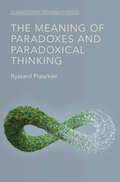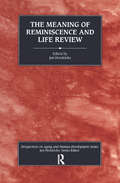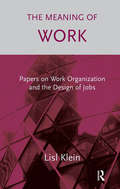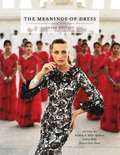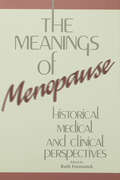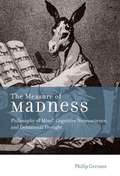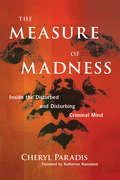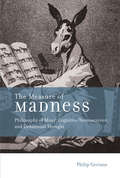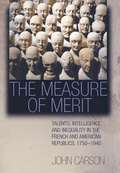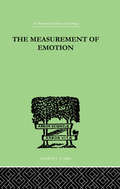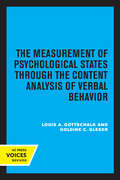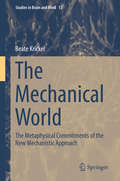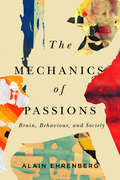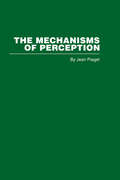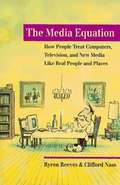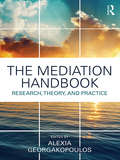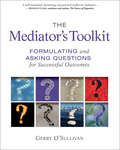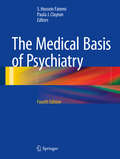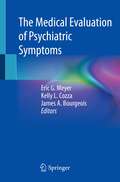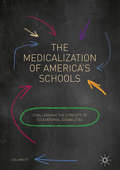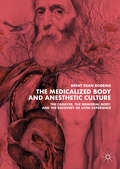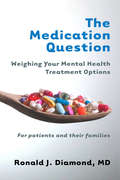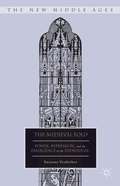- Table View
- List View
The Meaning of Paradoxes and Paradoxical Thinking (Cambridge Series on Possibility Studies)
by Ryszard PraszkierThis interdisciplinary work offers a comprehensive analysis of paradoxes and paradoxical thinking, exploring their manifestations in philosophy, societal dynamics, personality, and neuroscience. Demonstrating various methods for the augmentation of creativity and improved performance, this book uniquely integrates theoretical perspective with case studies and practical applications. As such it elucidates the theory and mechanisms of transforming the apparently impossible into the possible, illustrated by cases of social innovators successfully addressing insurmountable challenges. Aimed at graduate and postgraduate social science students and scholars, with over 500 bibliographical references, the text remains accessible to a broader audience due to its engaging language. Emphasizing the significance of paradoxes and paradoxical thinking in both professional and everyday contexts, it provides a nuanced exploration of paradoxical phenomena, making it a valuable resource for academic and general readers alike.
The Meaning of Reminiscence and Life Review (Perspectives On Aging And Human Development Ser.)
by Jon HendricksRobert Butler's call for life reviews has exerted a key influence on the way gerontologists have looked at reminiscence and remembering. Widely thought to be a helpful mechanism for integrating past and future, the process of life review needs better specification and evaluation based on sound research. ""The Meaning of Reminiscence and Life Review"" brings together both research and application pieces covering the range of possibilities. It examines important controversies and asks: ""Does it work?"" and ""What is the evidence?"" Given their own voice, what do old people say about looking back?
The Meaning of Suffering and Strife and Reconciliation (The Spiritual writings of Archimandrite Seraphi Aleksiev #Vol. II & III)
by Ralitsa DoynovaAlong with the current lack of belief and faith in God, truly the most piteous of all suffering is the lack of repentance--and therefore the lack of love. Repentance leads to the gateway of heaven and not only alleviates the anguish of suffering but actually transforms this suffering into the intense joy of being reunited with out Lord Jesus Christ.
The Meaning of Work: Papers on Work Organization and the Design of Jobs
by Lisl KleinLisl Klein has spent forty years working on the twin themes of the practice of social science in organizations and the importance of work and work organization. Papers on the first of these were published as Working Across the Gap. This volume brings together papers covering the second theme, the meaning and organization of work.
The Meanings of Dress (3rd Edition)
by Kimberly A. Miller-Spillman Patricia Hunt-Hurst Andrew ReillyThis collection of articles and essays from magazines, newspapers, books, and academic journals is designed to expand the reader's awareness and understanding of the role dress plays in cultures and subcultures across the globe. The text, which represents the very best thinking and writing on the subject today, explores essential topics such as dress and sociology, cultural studies, gender, religion, modesty, and technological changes. The Meanings of Dress, 3rd Edition is newly revised to reflect the current cultural landscape and includes more theory than previous editions, as well as an increased emphasis on the male perspective. The book provides design and merchandising students with insight into how - and why - consumers buy clothing and other products related to dress, and helps them to hone their trend forecasting skills.
The Meanings of Menopause: Historical, Medical, and Cultural Perspectives
by Ruth FormanekIn this scholarly compilation of a major event in the life of every woman, editor Ruth Formanek has adopted an avowedly multidisciplinary mandate: to illuminate menopause as both an event and a stage of life by gathering together a variety of discipline-specific meanings and research perspectives. The result is an admirably comprehensive study that not only charts the premodern meanings of menopause, but proceeds to examine menopause from current biomedical, endocrinological, culutral, and psychological perspectives. Ample attention is give to the psychosocial influences on menopause and to cross-cultural variations in the experience of, and life adjustments that follow, menopause. Societal and familial attitudes toward menopausal women are also explored through an examination of women in classical and modern literature. Clinical contributions review psychoanalytic perspectives on menopause, elucidate the individual meanings of the menopausal experience uncovered in therapy, and consider male views of menopausal women. Collectively, the contributors to this volume remedy the scant attention menopause has heretofore received in the psychological and psychotherapeutic literature. They not only explore the range of issues associated with menopause, but address these issues in the context of the various myths and superstitions about menopause that have endured over the centuries. Essential reading for students of human development, gender issues, and women's studies, The Meanings of Menopause is, for helping professionals, an invaluable source book on a life event fraught with psychological significance.
The Measure of Madness
by Philip GerransIn The Measure of Madness, Philip Gerrans offers a novel explanation of delusion. Over the last two decades, philosophers and cognitive scientists have investigated explanations of delusion that interweave philosophical questions about the nature of belief and rationality with findings from cognitive science and neurobiology. Gerrans argues that once we fully describe the computational and neural mechanisms that produce delusion and the way in which conscious experience and thought depend on them, the concept of delusional belief retains only a heuristic role in the explanation of delusion.Gerrans proposes that delusions are narrative models that accommodate anomalous experiences. He argues that delusions represent the operation of the Default Mode Network (DMN) -- the cognitive system that provides the raw material for humans' inbuilt tendency to provide a subjectively compelling narrative context for anomalous or highly salient experiences -- without the "supervision" of higher cognitive processes present in the nondelusional mind. This explanation illuminates the relationship among delusions, dreams, imaginative states, and irrational beliefs that have perplexed philosophers and psychologists for over a century. Going beyond the purely conceptual and the phenomenological, Gerrans brings together findings from different disciplines to trace the flow of information through the cognitive system, and applies these to case studies of typical schizophrenic delusions: misidentification, alien control, and thought insertion. Drawing on the interventionist model of causal explanation in philosophy of science and the predictive coding approach to the mind influential in computational neuroscience, Gerrans provides a model for integrative theorizing about the mind.
The Measure of Madness: Inside the Disturbed and Disturbing Criminal Mind
by Katherine Ramsland Dr Cheryl Paradis"The defendant told the jury that he did not kill girlfriend. He did, however, admit to dismembering her, boiling her bones, and hiding them in the Port Authority locker." At the heart of countless crimes lies the mystery of the human mind. In this eye-opening book, Dr. Cheryl Paradis draws back the curtain on the fascinating world of forensic psychology and revisits the most notorious and puzzling cases she has handled in her multifaceted career. "Out it all came, a slew of bizarre comments about the electronic chips implanted in his brain." Her riveting, sometimes shocking stories reveal the crucial and often surprising role forensic psychology plays in the pursuit of justice. Sometimes the accused believe their own bizarre lies, creating a world that pushes them into frightening, violent crimes. "My client is charged with murder and tells me he is a descendent of kings. He says he is of royal blood. Can you evaluate him for an insanity defense?" Join Dr. Paradis in a stark concrete cell, with the accused handcuffed to a chair opposite her, as she takes on the daunting task of mapping the suspect's madness--or exposing it as fakery. Have a front-row seat in a tense, packed courtroom, where her testimony can determine an individual's fate. The criminal mind has never been so intimately revealed--or so darkly compelling. "A forensic psychologist reveals the dark and troubling human mind. Fascinating."--Robert K. Tanenbaum The Experts PraiseThe Measure of Madness"Fascinating . . . A forensic psychologist reveals the dark and powerful motives that challenge our justice system and opens up the troubling workings of the human mind."--Robert K. Tanenbaum, author of Capture"Compelling . . . Dr. Cheryl Paradis offers a window into the world of a clinical psychologist who has made many assessments for the courts."--Katherine Ramsland, author of The Criminal Mind"Eloquent . . . Anyone concerned with the relationship between deviance and mental illness will find this excellent book to be of great value."--Simon Baatz, author of For the Thrill of It: Leopold, Loeb and the Murder that Shocked Chicago"Clearly written and comprehensive . . . Dr. Paradis skillfully leads the reader through the labyrinth of the psychotic criminal mind and the maze of the judicial system."--Barbara Kirwin, author of The Mad, the Bad, and the Innocent"Insightful, remarkable . . . not to be missed if you want to understand the real-world dramas that underlie criminal justice."--Barbara Oakley, author of Evil Genes"Informative, discussion-provoking . . . a much needed, intriguing collection of personal reflections as well as fascinating cases."--Thomas M. O'Rourke, Director of Forensic Psychiatry, Kings County Hospital Center"Riveting . . .Cheryl Paradis shows us a world rarely seen and one full of mystery."--John Coston, author of To Kill and Kill Again and Sleep My Child Forever"Lucid, intelligent, provocative . . . Cheryl Paradis is an articulate expert guide to the bizarre and routinely baffling world of irrational and aberrant crime."--Stephen G. Michaud, author of The Only Living Witness and Whisper of Fear"A marvelous book . . . a masterpiece that not only beautifully describes the people she examines but, just as importantly, fills in the dialogues between herself and others and includes her own thoughts and feelings. This book stands out."--Daniel W. Schwartz, M.D., Director (Ret.) of Forensic Psychiatry Service, Kings County Hospital"Written with clarity, objectivity, and expertise . . . Cheryl Paradis draws you into the fascinating world of the forensic psychologist and into the minds and often disturbing motives of the defendants she has examined."--Robert H. Berger, M.D., Clinical Professor of Psychiatry, New York University School of Medicine"Chilling . . . The Measure of Madness is an insider's view of a world few of us really know. Dr. Paradis makes clear that the reality of criminal forensic psychology is far different -- and far more fascinating -- than that portrayed in TV and movies. Fans of 'CSI' and 'Law and Order' as well as...
The Measure of Madness: Philosophy of Mind, Cognitive Neuroscience, and Delusional Thought (Life and Mind: Philosophical Issues in Biology and Psychology)
by Philip GerransDrawing on the latest work in cognitive neuroscience, a philosopher proposes that delusions are narrative models that accommodate anomalous experiences.In The Measure of Madness, Philip Gerrans offers a novel explanation of delusion. Over the last two decades, philosophers and cognitive scientists have investigated explanations of delusion that interweave philosophical questions about the nature of belief and rationality with findings from cognitive science and neurobiology. Gerrans argues that once we fully describe the computational and neural mechanisms that produce delusion and the way in which conscious experience and thought depend on them, the concept of delusional belief retains only a heuristic role in the explanation of delusion.Gerrans proposes that delusions are narrative models that accommodate anomalous experiences. He argues that delusions represent the operation of the Default Mode Network (DMN)—the cognitive system that provides the raw material for humans' inbuilt tendency to provide a subjectively compelling narrative context for anomalous or highly salient experiences—without the “supervision” of higher cognitive processes present in the nondelusional mind. This explanation illuminates the relationship among delusions, dreams, imaginative states, and irrational beliefs that have perplexed philosophers and psychologists for over a century.Going beyond the purely conceptual and the phenomenological, Gerrans brings together findings from different disciplines to trace the flow of information through the cognitive system, and applies these to case studies of typical schizophrenic delusions: misidentification, alien control, and thought insertion. Drawing on the interventionist model of causal explanation in philosophy of science and the predictive coding approach to the mind influential in computational neuroscience, Gerrans provides a model for integrative theorizing about the mind.
The Measure of Merit: Talents, Intelligence, and Inequality in the French and American Republics, 1750-1940
by John CarsonCarson tells the fascinating story of how two nations wrestled scientifically with human inequalities and their social and political implications. Surveying an array of political tracts, philosophical treatises, scientific works, and journalistic writings, he chronicles the gradual embrace of the IQ version of intelligence in the U.S., while in France, the birthplace of the modern intelligence test, expert judgment was consistently prized above such quantitative measures.
The Measurement of Affect, Mood, and Emotion
by Panteleimon EkkekakisThe role of affective constructs in human behavior in general, and health behavior in particular, is recapturing the attention of researchers. Affect, mood, and emotion are again considered powerful motives behind dietary choices, physical activity participation, cigarette smoking, alcohol over-consumption, and drug abuse. However, researchers entering the fray must confront a vast and confusing theoretical and technical literature. The enormity of this challenge is reflected in numerous problems plaguing recent studies, from selecting measures without offering a rationale, to interchanging terms that are routinely misconstrued. The Measurement of Affect, Mood, and Emotion cuts through the jargon, clarifies controversies, and proposes a sound three-tiered system for selecting measures that can rectify past mistakes and accelerate future progress. Panteleimon Ekkekakis offers an accessible and comprehensive guidebook of great value to academic researchers and postgraduate students in the fields of psychology, behavioral and preventive medicine, behavioral nutrition, exercise science, and public health.
The Measurement of Emotion (International Library Of Psychology Ser.)
by W Whately SmithFirst Published in 1999. Routledge is an imprint of Taylor & Francis, an informa company.
The Measurement of Psychological States Through the Content Analysis of Verbal Behavior
by Louis A. Gottschalk Goldine C. GleserThis title is part of UC Press's Voices Revived program, which commemorates University of California Press’s mission to seek out and cultivate the brightest minds and give them voice, reach, and impact. Drawing on a backlist dating to 1893, Voices Revived makes high-quality, peer-reviewed scholarship accessible once again using print-on-demand technology. This title was originally published in 1969.
The Mechanical World: The Metaphysical Commitments of the New Mechanistic Approach (Studies in Brain and Mind #13)
by Beate KrickelThis monograph examines the metaphysical commitments of the new mechanistic philosophy, a way of thinking that has returned to center stage. It challenges a variant of reductionism with regard to higher-level phenomena, which has crystallized as a default position among these so-called New Mechanists. Furthermore, it opposes those philosophers who reject the possibility of interlevel causation. Contemporary philosophers believe that the explanation of scientific phenomena requires the discovery of relevant mechanisms. As a result, new mechanists are, in the main, concerned solely with epistemological questions. But, the author argues, their most central claims rely on metaphysical assumptions. Thus, they must also take into account metaphysics, a system of thought concerned with explaining the fundamental nature of being and the world around it. This branch of philosophy does indeed matter to the empirical sciences. The chapters investigate the nature of mechanisms, their components, and the ways in which they can bring about different phenomena. In addition, the author develops a novel account of causation in terms of activities. The analysis provides the basis for many further research projects on mechanisms and their relations to, for example, the mind-body problem, realization, multiple realization, natural kinds, causation, laws of nature, counterfactuals, and scientific levels.
The Mechanics of Passion: Brain, Behaviour, and Society
by Alain EhrenbergCognitive neuroscience, once a specialized area of psychology and biology, has enjoyed increased worldwide legitimacy in the last thirty years not only in psychiatry and mental health, but also in fields as diverse as education, economics, marketing, and law. How can this surge in popularity be explained? Has the new science of human behaviour now become the barometer of our conduct and our lives, taking the place previously occupied by psychoanalysis? Rather than asking if neuronal man will replace social man or how to surmount the opposition between the biological and the social, The Mechanics of Passions uncovers hidden relationships between global social ideals and specialized concepts of neuroscience and cognitive science. Proposing a historical sociology situated in the dual contexts of the history of sciences and the history of self-representation, Alain Ehrenberg describes the conditions through which cognitive neuroscience has developed and acquired a strong moral authority in our individualistic society permeated by ideas, values, and norms of autonomy. Cognitive neuroscience offers the promise of turning personal limitations into assets by exploring an individual's "hidden potential." The Mechanics of Passions identifies this as the echo of social ideals of autonomy, affirming that the moral authority of cognitive neuroscience stems as much from cultural norms as from any results of scientific or medical experimentation.
The Mechanisms of Perception
by Jean PiagetFirst published in 2006. Routledge is an imprint of Taylor & Francis, an informa company.
The Media Equation: How People Treat Computers, Televisions, and New Media Like Real People and Places
by Byron Reeves Clifford NassAccording to popular wisdom, humans never relate to a computer or a television program in the same way they relate to another human being. Or do they? The psychological and sociological complexities of the relationship could be greater than you think. In an extraordinary revision of received wisdom, Byron Reeves and Clifford Nass demonstrate convincingly in The Media Equation that interactions with computers, television, and new communication technologies are identical to real social relationships and to the navigation of real physical spaces. Using everyday language, the authors explain their novel ideas in a way that will engage general readers with an interest in cutting-edge research at the intersection of psychology, communication and computer technology. The result is an accessible summary of exciting ideas for modern times. As Bill Gates says, '(they) ... have shown us some amazing things'.
The Mediation Handbook: Research, theory, and practice
by Alexia GeorgakopoulosThe Handbook of Mediation gathers leading experts across fields related to peace, justice, human rights, and conflict resolution to explore ways that mediation can be applied to a range of spectrums, including new age settings, relationships, organizations, institutions, communities, environmental conflicts, and intercultural and international conflicts. The text is informed by cogent theory, state-of-the-art research, and best practices to provide the reader with a well-rounded understanding of mediation practice in contemporary times. Based on four signature themes—contexts; skills and competencies; applications; and recommendations—the handbook provides theoretical, applicable, and practical insight into a variety of key approaches to mediation. Authors consider modern conflict on a local and global scale, emphasizing the importance of identifying effective strategies, foundations, and methods to shape the nature of a mediation mindfully and effectively. With a variety of interdisciplinary perspectives, the text complements the development of the reader’s competencies and understanding of mediation in order to contribute to the advancement of the mediation field. With a conversational tone that will welcome readers, this comprehensive book is essential reading for students and professionals wanting to learn a wide range of potential interventions for conflict.
The Mediator's Toolkit: Formulating and Asking Questions for Successful Outcomes
by Gerry O'Sullivan“Dives deep into the psychology of information and emotion in conflict situations . . . Highly recommended for facilitators and negotiators as well as mediators.” —Jennifer Beer, author of The Mediator’s Handbook and negotiation instructor at Wharton School, University of PennsylvaniaKnowing how to formulate and ask incisive questions to get to the core of a conflict, challenge entrenched thinking, and shift perspectives is the key to successful conflict resolution. The Mediator’s Toolkit employs the author’s powerful “S Questions Model” to provide readers with the skills and tools to do just that. It addresses four dimensions of successful questions for mediation: the subject matter dimension, the structure dimension, the information-seeking dimension, and the shifting thinking dimension. The toolkit clearly explains:The theory behind each question type, including exploration of relevant neuroscience and psychologyThe purpose of different types of questionsHow the questions workWhen to use different types of questionsHow to build and apply questions to mediation in a non-threatening wayThis essential practical guide will radically sharpen, focus, and improve the questioning skills of qualified mediators, students, lecturers, trainers, and those using questions to challenge and effect change, in any context.
The Medical Basis of Psychiatry
by S. Hossein Fatemi Paula J. ClaytonFour years have passed since the last edition (3rd) of this book was published. In the intervening years, several reviews of this book have provided highly encouraging remarks about the value of this book in transmitting information on classification and treatment of psychiatric disorders to the audience. We are proposing to revise all chapters with an eye on accuracy and ease of use, and this is an especially timely endeavor with the upcoming publication of the Diagnostic and Statistical Manual V. All the appropriate new information on biology, etiology, diagnosis and treatment of psychiatric disorders will be added to the current proposed edition. It is our goal to recruit the same authors (if possible) who contributed to the previous edition. While all chapters will be updated (see TOC), those marked by asterisks will be the most likely to undergo more revision. Psychiatry has emerged as a burgeoning scientific field with major advances in etiology and treatment of several disorders. Just as there was excitement in the anatomic advances that took place a hundred years ago when Emil Kraepelin and his collaborators took on the enormous task of classification of psychiatric disorders based on rational scientific thinking, new advances in genetics, biochemistry, neuroanatomy and pharmacotherapy of mental disorders have brought us even closer to a better understanding of complex disorders like schizophrenia, bipolar disorder, depression and even autism. The major goal of the previous edition of this classic book was to update the busy clinician, psychiatric resident and medical student with the most up-to-date information on etiology, diagnosis and treatment of psychiatric disorders. This goal remains the focus of the fourth edition of this book. In this updated and expanded edition, the reader will be provided with the most contemporary information and literature supported by a close survey of the field. This new edition of this classic title, with its focus on biologic and medical aspects of psychiatry, will continue to be of significant help to all interested in the scientific practice of psychiatry.
The Medical Evaluation of Psychiatric Symptoms
by James A. Bourgeois Eric G. Meyer Kelly L. CozzaEvery DSM-5 diagnosis includes an exclusion criterion that the disorder is not better explained by a medical condition. Meeting this criterion can be difficult for a variety of reasons. The psychiatric signs and symptoms of medical disorders are not commonly emphasized in medical textbooks. Further, illness scripts for medical diagnoses do not often overlap with psychiatric disorders, making it difficult to know what medical conditions should be ruled out. For example, irritability is a common symptom in polycystic ovarian disorder, but PCOS is rarely on the differential for irritability. Similarly, while hypothyroidism is commonly linked to the illness script of depression, patients with MDD may be just as likely to have diabetes - an infrequently considered diagnosis for depression. “Buzzword” medical conditions that are commonly prioritized in medical student training can negatively influence classic illness scripts. While such diagnostic possibilities make for good multiple-choice questions, they are frequently rare and may inadvertently undermine important common possibilities. For example, a patient with chest pain in the context of anxiety is more likely to have asthma, acute coronary syndrome, or even a pulmonary embolism than pheochromocytoma. In a recent white paper issued by the American Psychiatric Association, it has urged psychiatrists to better advocate for patients with severe mental illness who often lack access to primary care. But some psychiatrists may be unfamiliar with physical exam maneuvers and medical review of systems (ROS) questions. Complex medical systems may delegate the physical exam to physicians outside of psychiatry, or there may be a temptation to rely on the emergency room’s “medical clearance” as a “medical rule-out.” Both can result in decreased familiarity with physical exam techniques previously mastered as part of medical school. A cursory review of the physical exam maneuvers and concise symptom-based medical ROS lists can alleviate some of these concerns. This book is intended to provide psychiatrists and physicians who routinely evaluate psychiatric symptoms with the tools needed to rule out medical conditions that could be causing those symptoms. It will start with an introduction that reviews why the text is needed and potential larger gaps in training that might contribute to the necessity for such a text. Each chapter thereafter will focus on a specific symptom. Each symptom will be defined to ensure accuracy. Then a differential of common medical conditions that can cause that psychiatric symptom will be provided. For each diagnosis key history, physical exam, laboratory, and radiologic findings will be provided that help rule the condition out. Screening tools that can help rule out medical etiologies will also be provided. Where available, positive predictive values (PPVs) will be provided to help users understand the likelihood that a negative finding or result indicated that a medical disorder is not present. While individual aspects of this text exist in other formats, the comprehensive nature of our approach, descriptions of psychiatric symptoms to means of ruling out potential medical etiologies, is not currently available to providers. This text will assist providers in ruling out medical etiologies of common psychiatric symptoms, ensuring patients are diagnosed correctly. Such an improvement has the potential to dramatically improve patient outcomes.
The Medicalization of America's Schools
by Joel MachtThis book challenges the validity of ADHD, learning disabilities, and dyslexia as meaningful special education "categories" and critically examines the misplaced medical model from which they are derived. The presumption that these disabilities cause school-related problems detracts from identifying factors within the classroom that create and maintain a child's underachievement and disruptive behavior. Moreover, when the disability is finally named, it provides no functional information that translates into effective coping strategies. Macht delves into the misunderstood structure of these disabilities, pointing out that they are not verifiable disabilities but weak constructs that poorly describe each child's uniqueness. Finally, he provides an alternative model based on children's strengths rather than their deficiencies, and presents strategies that advance school-related success.
The Medicalized Body and Anesthetic Culture: The Cadaver, The Memorial Body, And The Recovery Of Lived Experience
by Brent Dean RobbinsThis book examines how modern medicine’s mechanistic conception of the body has become a defense mechanism to cope with death anxiety. Robbins draws from research on the phenomenology of the body, the history of cadaver dissection, and empirical research in terror management theory to highlight how medical culture operates as an agent which promotes anesthetic consciousness as a habit of perception. In short, modern medicine’s comportment toward the cadaver promotes the suppression of the memory of the person who donated their body. This suppression of the memorial body comes at the price of concealing the lived, experiential body of patients in medical practice. Robbins argues that this style of coping has influenced Western culture and has helped to foster maladaptive patterns of perception associated with experiential avoidance, diminished empathy, death denial, and the dysregulation of emotion.
The Medication Question: Weighing Your Mental Health Treatment Options
by Ronald J. DiamondHelping readers understand the factors and considerations when deciding whether or not to take psychotropic drugs. This important volume provides a thorough overview of a range of mental disorders, describing how they are affected by various medications and other interventions, to foster a strong alliance between family, patient, and clinician. Diamond asks us to step well back from the brink of the "doctor knows best" mentality, addressing a more basic and radical question: Do I (or does my family member) really need medication, and if so, why, what, when, how and for how long? What is the problem for which I might be considering taking medication? Diamond faces the facts that some individuals do not benefit from medication, that taking medication regularly should never be the goal of treatment (as it often seems to be), and that medication in some conditions may have meaning and utility for the person even when there is no proven clinical indication for it. This book is an invaluable guide to medications--including complementary and herbal products--that you might consider for various psychiatric and psychological conditions. Clinicians, clients, and family members alike will learn to collaborate, negotiate, create individualized treatment plans, and share in the decision-making process about whether to medicate or not.
The Medieval Fold
by Suzanne VerderberStriking cultural developments took place in the twelfth century which led to what historians have termed 'the emergence of the individual. ' The Medieval Fold demonstrates how cultural developments typically associated with this twelfth-century renaissance autobiography, lyric, courtly love, romance can be traced to the Church's cultivation of individualism. However, subjects did not submit to pastoral power passively, they constructed fantasies and behaviors, redeploying or 'folding' it to create new forms of life and culture. Incorporating the work of Nietzsche, Foucault, Lacan, and Deleuze, Suzanne Verderber presents a model of the subject in which the opposition between interior self and external world is dislodged.
